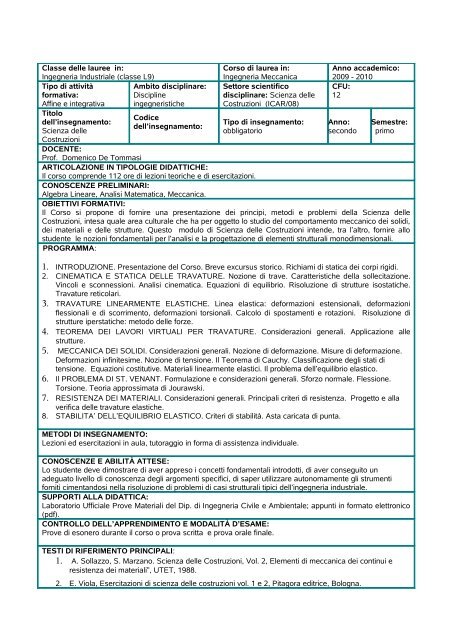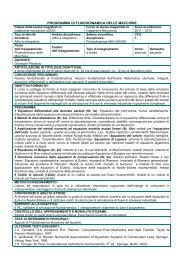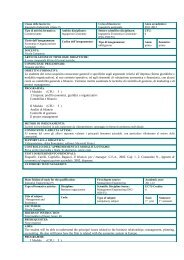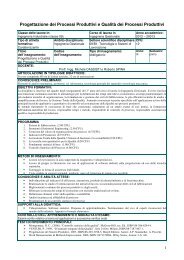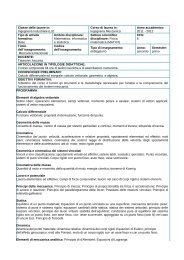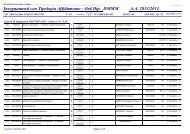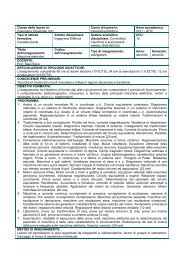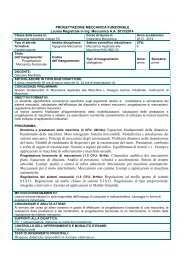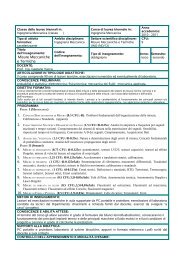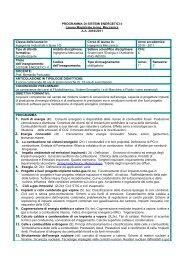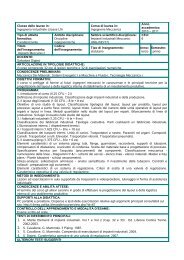De Tommasi
De Tommasi
De Tommasi
You also want an ePaper? Increase the reach of your titles
YUMPU automatically turns print PDFs into web optimized ePapers that Google loves.
Classe delle lauree in:<br />
Ingegneria Industriale (classe L9)<br />
Tipo di attività<br />
formativa:<br />
Affine e integrativa<br />
Titolo<br />
dell’insegnamento:<br />
Scienza delle<br />
Costruzioni<br />
Ambito disciplinare:<br />
Discipline<br />
ingegneristiche<br />
Codice<br />
dell’insegnamento:<br />
Corso di laurea in:<br />
Ingegneria Meccanica<br />
Settore scientifico<br />
disciplinare: Scienza delle<br />
Costruzioni (ICAR/08)<br />
Tipo di insegnamento:<br />
obbligatorio<br />
Anno accademico:<br />
2009 - 2010<br />
CFU:<br />
12<br />
Anno:<br />
secondo<br />
Semestre:<br />
primo<br />
DOCENTE:<br />
Prof. Domenico <strong>De</strong> <strong>Tommasi</strong><br />
ARTICOLAZIONE IN TIPOLOGIE DIDATTICHE:<br />
Il corso comprende 112 ore di lezioni teoriche e di esercitazioni.<br />
CONOSCENZE PRELIMINARI:<br />
Algebra Lineare, Analisi Matematica, Meccanica.<br />
OBIETTIVI FORMATIVI:<br />
Il Corso si propone di fornire una presentazione dei principi, metodi e problemi della Scienza delle<br />
Costruzioni, intesa quale area culturale che ha per oggetto lo studio del comportamento meccanico dei solidi,<br />
dei materiali e delle strutture. Questo modulo di Scienza delle Costruzioni intende, tra l’altro, fornire allo<br />
studente le nozioni fondamentali per l’analisi e la progettazione di elementi strutturali monodimensionali.<br />
PROGRAMMA:<br />
1. INTRODUZIONE. Presentazione del Corso. Breve excursus storico. Richiami di statica dei corpi rigidi.<br />
2. CINEMATICA E STATICA DELLE TRAVATURE. Nozione di trave. Caratteristiche della sollecitazione.<br />
Vincoli e sconnessioni. Analisi cinematica. Equazioni di equilibrio. Risoluzione di strutture isostatiche.<br />
Travature reticolari.<br />
3. TRAVATURE LINEARMENTE ELASTICHE. Linea elastica: deformazioni estensionali, deformazioni<br />
flessionali e di scorrimento, deformazioni torsionali. Calcolo di spostamenti e rotazioni. Risoluzione di<br />
strutture iperstatiche: metodo delle forze.<br />
4. TEOREMA DEI LAVORI VIRTUALI PER TRAVATURE. Considerazioni generali. Applicazione alle<br />
strutture.<br />
5. MECCANICA DEI SOLIDI. Considerazioni generali. Nozione di deformazione. Misure di deformazione.<br />
<strong>De</strong>formazioni infinitesime. Nozione di tensione. Il Teorema di Cauchy. Classificazione degli stati di<br />
tensione. Equazioni costitutive. Materiali linearmente elastici. Il problema dell’equilibrio elastico.<br />
6. Il PROBLEMA DI ST. VENANT. Formulazione e considerazioni generali. Sforzo normale. Flessione.<br />
Torsione. Teoria approssimata di Jourawski.<br />
7. RESISTENZA DEI MATERIALI. Considerazioni generali. Principali criteri di resistenza. Progetto e alla<br />
verifica delle travature elastiche.<br />
8. STABILITA’ DELL’EQUILIBRIO ELASTICO. Criteri di stabilità. Asta caricata di punta.<br />
METODI DI INSEGNAMENTO:<br />
Lezioni ed esercitazioni in aula, tutoraggio in forma di assistenza individuale.<br />
CONOSCENZE E ABILITÀ ATTESE:<br />
Lo studente deve dimostrare di aver appreso i concetti fondamentali introdotti, di aver conseguito un<br />
adeguato livello di conoscenza degli argomenti specifici, di saper utilizzare autonomamente gli strumenti<br />
forniti cimentandosi nella risoluzione di problemi di casi strutturali tipici dell’ingegneria industriale.<br />
SUPPORTI ALLA DIDATTICA:<br />
Laboratorio Ufficiale Prove Materiali del Dip. di Ingegneria Civile e Ambientale; appunti in formato elettronico<br />
(pdf).<br />
CONTROLLO DELL’APPRENDIMENTO E MODALITÀ D’ESAME:<br />
Prove di esonero durante il corso o prova scritta e prova orale finale.<br />
TESTI DI RIFERIMENTO PRINCIPALI:<br />
1. A. Sollazzo, S. Marzano. Scienza delle Costruzioni, Vol. 2, Elementi di meccanica dei continui e<br />
resistenza dei materiali”, UTET, 1988.<br />
2. E. Viola, Esercitazioni di scienza delle costruzioni vol. 1 e 2, Pitagora editrice, Bologna.
3. Dispense didattiche del docente disponibili in formato elettronico (pdf) sul sito<br />
http://www.dica.poliba.it<br />
ULTERIORI TESTI SUGGERITI:<br />
E. Benvenuto : La scienza delle costruzioni e il suo sviluppo storico , Sansoni, Firenze, 1981.<br />
P. Podio-Guidugli: Lezioni di Scienza delle Costruzioni, Aracne, 2008.<br />
<strong>De</strong>gree class:<br />
Industrial engineering<br />
Type of subject<br />
Integrating engineering<br />
subject<br />
Title of the course:<br />
Mechanics of Solids<br />
and Structures<br />
Disciplinary area:<br />
Engineering<br />
Code:<br />
LECTURER:<br />
Prof. Domenico <strong>De</strong> <strong>Tommasi</strong><br />
HOURS OF INSTRUCTION<br />
112 hours of lectures and classroom applications.<br />
PREREQUISITES:<br />
Linear Algebra; Mathematical Analysis; Mechanics.<br />
AIMS:<br />
Second level degree:<br />
Mechanical engineering<br />
Scientific Discipline Sector:<br />
Mechanics of Solids and<br />
Structures (ICAR/08)<br />
Type of course:<br />
compulsory<br />
Academic year:<br />
2009 - 2010<br />
ECTS Credits:<br />
12<br />
Year:<br />
2 nd year<br />
Semester<br />
:<br />
1 st<br />
semester<br />
The course provides an introduction of the methods and problems of Structural Mechanics by focusing on the<br />
study of the mechanical behaviour of solids, materials and structures. In particular, the course delivers the<br />
instruments for the analysis and design of one-dimensional structural elements. The student is directly<br />
involved in solving structural problems related to the industrial engineering.<br />
PROGRAMME:<br />
1. INTRODUCTION. Presentation of the course. Short historical excursus. Overview on statics of rigid<br />
bodies.<br />
2. KINEMATICS AND STATICS OF BEAMS. Beam model. Internal forces. Constraints and connections.<br />
Equilibrium conditions. Statically determined structures. Trusses.<br />
3. LINEARLY ELASTIC STRUCTURES. Elastica for normal force, shear, bending and torsion. Evaluation of<br />
displacements and rotations. Statically undetermined structures and frames.<br />
4. VIRTUAL WORK THEOREM. General setting and applications for structures.<br />
5. SOLID MECHANICS. General considerations. <strong>De</strong>formation. <strong>De</strong>formation measures. Infinitesimal<br />
deformations. Stress. Cauchy theorem. Principal stresses. Constitutive relations. Linear elastic materials.<br />
The equilibrium problem for elastic bodies.<br />
6. ST. VENANT PROBLEM. Formulation of the problem and general observations. Normal force. Bending.<br />
Torsion. Jourawski theory.<br />
7. STRENGTH OF MATERIALS. General considerations. Material strength criteria. Analysis and design of<br />
elastic structures.<br />
8. ELASTIC STABILITY. Stability criteria. Stability of axially loaded beams.<br />
TEACHING METHODS:<br />
In class lectures and exercise lessons.<br />
EXPECTED OUTCOME AND SKILL:<br />
The student has to show his comprehension and knowledge of the basic concepts introduced in the course<br />
and, by solving specific problems, he has to prove his ability in applying the main topics of the course to the<br />
analysis of structures.<br />
TEACHING AIDS:<br />
Laboratory of Dip. di Ingegneria Civile e Ambientale; course notes (pdf). .<br />
EXAMINATION METHOD:
The exam consists of two written tests (or a final written test) and a final oral test.<br />
BIBLIOGRAPHY:<br />
1. A. Sollazzo, S. Marzano. Scienza delle Costruzioni, Vol. 2, Elementi di meccanica dei continui e<br />
resistenza dei materiali”, UTET, 1988.<br />
2. E. Viola, Esercitazioni di scienza delle costruzioni vol. 1 e 2, Pitagora editrice, Bologna.<br />
3. Dispense didattiche del docente disponibili in formato elettronico (pdf) sul sito<br />
http://www.dica.poliba.it<br />
FURTHER BIBLIOGRAPHY:<br />
E. Benvenuto : La scienza delle costruzioni e il suo sviluppo storico , Sansoni, Firenze, 1981.<br />
P. Podio-Guidugli: Lezioni di Scienza delle Costruzioni, Aracne, 2008.


